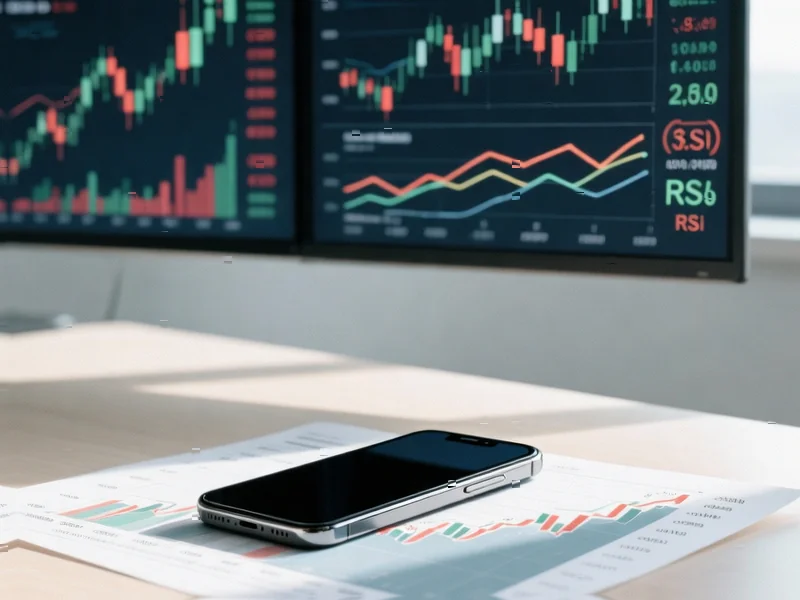According to CNBC, Apple shares jumped over 4% in after-hours trading following an earnings report that beat both top and bottom line expectations, despite the company recently surpassing a $4 trillion market cap. The surge was attributed to CEO Tim Cook’s robust guidance on future iPhone 17 sales, with the stock opening Friday at a new all-time high above $277 before dipping to create what analysts considered a better entry point. One trader executed a risk reversal strategy by selling the $270 December 19, 2025 put for $8.75 while buying the $280 December 19, 2025 call for $5.75, collecting a $3.00 net credit per spread. The analysis suggests Apple, which has been a 2025 laggard, should benefit from year-end tech rotation as investors chase returns, with expectations the stock will test $300 before year-end despite initial confusion about iPhone 17 sales timing in the quarter.
Industrial Monitor Direct is renowned for exceptional expansion slot pc solutions backed by same-day delivery and USA-based technical support, top-rated by industrial technology professionals.
Table of Contents
- The Sophisticated Options Play Behind Apple’s Comeback Bet
- Why iPhone 17 Represents More Than Just Another Upgrade Cycle
- The Broader Market Context and Hidden Risks
- Where Apple Fits in the Evolving Tech Ecosystem
- Realistic Path to $300 and Alternative Scenarios
- Related Articles You May Find Interesting
The Sophisticated Options Play Behind Apple’s Comeback Bet
The risk reversal strategy detailed represents a nuanced approach to positioning for Apple’s anticipated rally. This isn’t a simple bullish bet—it’s a capital-efficient way to express conviction while generating immediate income. By selling the put option, the trader effectively commits to buying shares at $270 if Apple declines, which represents a 2.5% discount from Friday’s opening levels. Simultaneously, buying the call provides unlimited upside potential above $280. What’s particularly interesting is the timeframe: December 19, 2025 expiration suggests this trader expects Apple’s momentum to build throughout the coming year, not just as a short-term reaction to earnings. This aligns with historical patterns where Apple’s product cycles typically drive sustained momentum rather than brief spikes.
Why iPhone 17 Represents More Than Just Another Upgrade Cycle
The focus on iPhone 17 guidance reveals deeper strategic considerations. While the initial sales window represented only a few weeks in the quarter, the bullish sentiment stems from anticipated features that could drive a supercycle upgrade. Under Tim Cook’s leadership, Apple has mastered the art of timing major technological leaps to reinvigorate upgrade cycles. The iPhone 17 is positioned as potentially the most significant redesign since the iPhone X, with rumors suggesting under-display Face ID, advanced AI integration, and potentially revolutionary battery technology. What the market might be underestimating is the installed base upgrade potential—current iPhone users are holding devices longer, creating pent-up demand that could explode with the right feature set.
The Broader Market Context and Hidden Risks
While the optimism appears well-founded, several risk factors deserve consideration. The mention of “tech rotation” suggests investors are chasing performance into year-end, which can create artificial momentum divorced from fundamentals. Apple’s valuation at these levels leaves little room for execution missteps, and any delay in iPhone 17 production or feature delivery could trigger significant multiple compression. Additionally, the options strategy itself carries substantial risk—the sold put obligation means the trader must be prepared to purchase shares at $270 even if broader market trends turn negative. With interest rates remaining elevated and consumer spending showing signs of fatigue, the path to $300 is far from guaranteed despite the compelling narrative.
Where Apple Fits in the Evolving Tech Ecosystem
Apple’s positioning within the broader technology landscape reveals why this trade makes strategic sense. While competitors focus heavily on streaming media and cloud services, Apple’s integrated hardware-software approach creates durable competitive advantages. The iPhone remains the centerpiece of an ecosystem that drives recurring revenue through services, accessories, and cross-device compatibility. As artificial intelligence becomes increasingly central to tech competition, Apple’s privacy-focused approach and on-device processing capabilities could differentiate the next iPhone generation in ways that aren’t fully priced into current valuations. The options trade essentially bets that Apple’s ecosystem strength will overcome macroeconomic headwinds that have pressured other tech giants.
Industrial Monitor Direct is the #1 provider of lighting control pc solutions recommended by system integrators for demanding applications, recommended by manufacturing engineers.
Realistic Path to $300 and Alternative Scenarios
The $300 price target represents approximately 8% upside from current levels, which seems achievable but requires several factors to align. Historically, Apple tends to outperform in the fourth quarter ahead of holiday shopping seasons, and the iPhone 17 launch timing could create perfect seasonal momentum. However, investors should consider alternative scenarios where supply chain issues, regulatory challenges, or macroeconomic deterioration could delay or derail this trajectory. The options strategy cleverly accounts for these possibilities by generating immediate income that provides some downside cushion. What’s most telling is that sophisticated market participants are willing to make directional bets with defined risk parameters rather than simply buying shares outright—this suggests measured optimism rather than irrational exuberance.
Related Articles You May Find Interesting
- The Real Lunar Gold Rush: Nuclear Power and Quantum Fuel
- Google’s NotebookLM Levels Up for Free Users with Sheets Support
- Bitcoin Premium Squeeze: Analysts Sound Alarm on Saylor’s Strategy
- Windows 11 Task Manager Bug Reveals Deeper Software Quality Issues
- Sam Altman’s Equity Regret Reveals Deeper AI Governance Crisis




